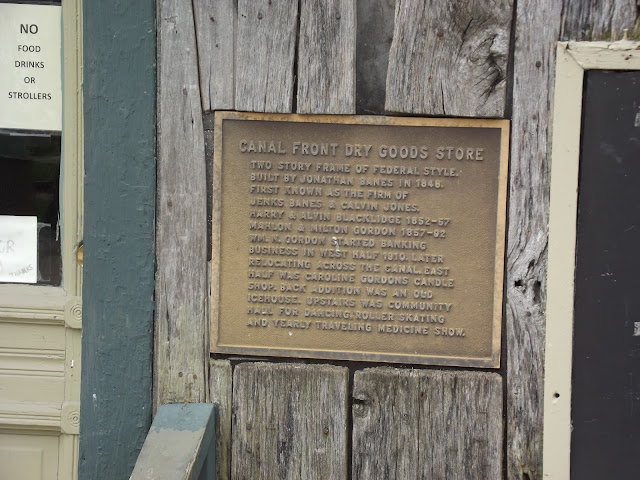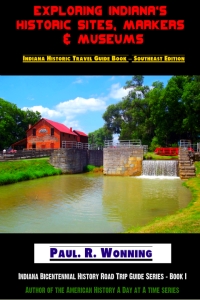 |
| Canal Front Dry Good Store - Metamora, Indiana |
Canal Front Dry Good Store
Canal Front
Erected by:
Indiana Division of Tourism and the Metamora Shop Keepers 1976
Located:
Main Street near Banes Street, Metamora, Indiana (#72 on Metamora Map)
Text:
Two story frame of Federal Style built by Jonathan Banes in 1848. First known as the firm of Jenks, Banes and Calvin Jones. Harry and Alvin Blacklidge 1852-57. Mahlon and Milton Gordon 1857-62. Wm. N. Gordon started banking business in west half 1910. Later relocated across the canal, east half was Caroline Gordon’s Candle Shop. Back addition was an old icehouse, upstairs was community hall for dancing, roller skating and yearly traveling medicine show.
 |
| Franklin County Historical Marker |
Brief History by the Author
Ice House
Cutting the Ice
The icehouse was a common structure in the Eighteenth and early Nineteenth Century in the days before artificial refrigeration became common. During the winter months, farmers and icemen would cut ice from local ponds and lakes after the ice had gotten about a foot thick. Because snow cover will slow the freezing process, many times the workers would remove any snow cover from the pond so the ice would freeze faster. First, they would use a handsaw to cut the ice into long strips. Then they would cut the strips into blocks; lift the blocks from the water using a special tool called an ice tongs. After cutting, they would load the ice blocks on horse drawn wagons and transport the ice blocks to the icehouse. A team of men could cut and transport several tons of ice a day.
Storage and Use
Upon arrival at the icehouse, the men would load the ice into the icehouse. The icehouse was insulated with sawdust or straw to help maintain the freezing temperatures needed by the stored ice. They loaded it in layers, packing either sawdust or straw between the blocks and layers, until the icehouse was full. Properly packed ice would stay frozen until the following winter. During the summer, the iceman would load blocks of ice onto a horse drawn wagon and deliver ice to homes that had iceboxes. Children often followed the ice wagons, picking up fallen chips of ice for a cold, summer treat. Most homes had iceboxes for storing milk, butter, cream and other food items that needed refrigeration. The icebox was usually constructed from wood. The walls, back and doors were hollow, lined with zinc or some other non-corrosive material and insulated with sawdust, cork or seaweed. The ice compartment was in the top, which allowed the cooled air to circulate down into the food storage compartments below. Many of the iceboxes had drainage taps to drain the melted water from the ice compartment, a daily chore.
 |
| Driving the Canals and Rivers Auto Trail |
During the summer months, the frozen ice provided an additional treat. On holidays like Decoration Day (Memorial Day), Fourth of July and Labor Day strong armed men would take chips of ice to make ice cream in an ice cream maker. The ice cream maker consisted of a wooden bucket that had a metal tub inside. They filled the metal tub with their ice cream mix and inserted a metal paddle into the mix. After placing a lid on the tub, they placed it inside the wooden bucket. The ice cream maker had a specially made gear mechanism that allowed someone to turn a crank that spun the tub inside the bucket. The paddle inside the tub would also turn; mixing the ice cream as it froze, keeping it from becoming a frozen, solid mass. They placed ice chips in the area between the tub and bucket and sprinkled salt over the ice chips. Men would then spend an afternoon taking turns turning the crank, spinning the tub inside the ice/salt mix. A hole in the side of the bucket allowed cold water to escape as the ice melted. Occasionally the ice would have to be replenished and more salt added. The spinning tub in the ice/salt mix slowly froze the sweet concoction inside the tub, which turned harder and harder as the ice cream froze. At length, the ice cream was ready for the waiting crowd to sate their appetite for the rare summer treat.
By the 1930's modern refrigeration began displacing the icehouse as a fixture in American towns.
Traveling Medicine Show
In an age of uncertain medical practices that included bleeding, sometimes using leeches, cold baths and skin blistering agents, people often turned to other means of affecting cures for their various ailments. The traveling medicine show answered this need, in spite of the dubious concoctions offered by the people running the show. The medicine show also provided an entertainment venue not available to many small towns across Indiana in the Nineteenth and early Twentieth Centuries.
Began the Age of Advertising
The patent medicines offered by the operators of these shows became the first products using modern, mass advertising techniques. Before the show came to town, promoters would place posters along the proposed route of the show, advertising the shows, medicines and other information about the event. The advertising stressed that the medicines used rare, exotic ingredients that promised miracle cures to the buyers of the medicine.
The Medicines
Commonly called "patent medicine" in spite of the fact that very few were patented, the medicines consisted of cheap materials sold at a high price. The ingredients commonly consisted of cocaine, opium, and/or high concentrations of alcohol. The addictive nature of these medicines encouraged continued purchases of the "medicines" after the event. Buyers could order the medicines by mail order, or sometimes at local stores, after the show left town. Many of the liniments and ointments advertised the main ingredient as "snake oil," which many people at the time considered a cure all. Many times the operator of the show mixed the medicines in his "medicine wagon" before the show.
The "Doctors"
Often called "doctor" or "professor" the operators of the traveling medicine shows were nothing of the sort. Talented entertainers, they would use the power of entertainment, persuasion, jingles, fear and testimonials from "cured" patients.
 |
| Exploring Indiana's Historic Sites, Markers & Museums - South East Edition |
The medicine show consisted of the "Professor" hawking his product, interspersed with entertainment acts that usually included juggling, a flea circus, musical performances, a magician and other forms of entertainment. The Professor would talk about the benefits of his offering, and then break to allow the entertainers to soften resistance to his pitch. This pattern would repeat several times during the show, which was free to all comers. The operator also used planted shills in the to provide "unsolicited" testimonials and "plants" that would come forward with an obvious affliction, such as a limp, who would be miraculously "cured" after taking a swig of the "medicine."
Regulations and Better Medicines
These patent medicines did not really cure any of the illnesses they purported to cure. Many of them caused more problems than they solved because of their addictive nature. Their use also discouraged people from going to a real medical doctor for treatment. By the early Twentieth Century state and federal lawmakers began passing laws regulating medicines. Medical science began producing reliable, consistent drugs. The two developments caused a decline in the traveling medical show. The tradition lives on in the names of many popular musical groups. Many of the terms used today, like snake oil, quack and several others live on in the language.
From the Author's Book:
Driving the Canals and Rivers Auto Trail
Franklin County Convention, Recreation and Visitors Commission
18 West 10th Street
P.O. Box 97
Brookville, IN 47012
Comments
Post a Comment